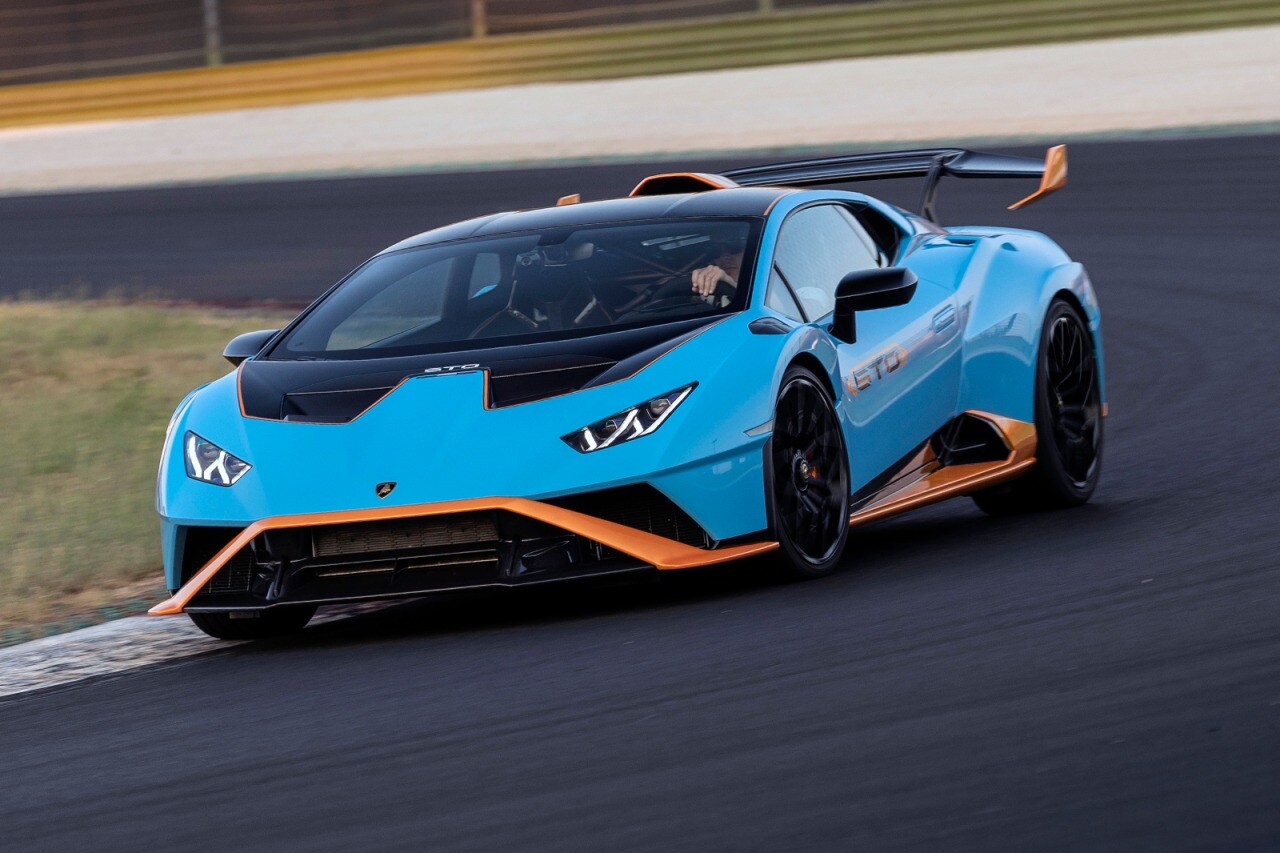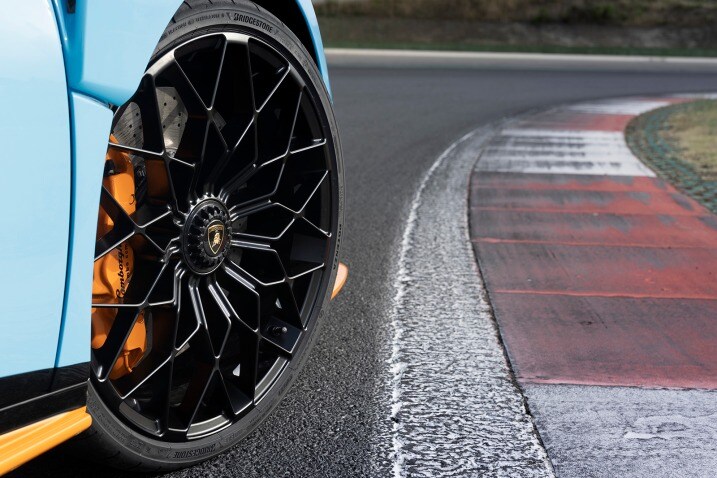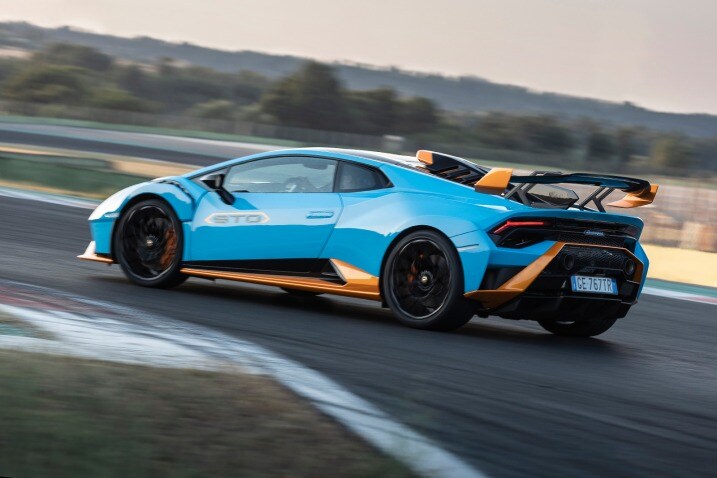- It's OK if you buy it for the V10 engine alone.
- The Huracan STO's brakes are nothing short of amazing.
- You could, and should, drive it all day on a racetrack.
TESTED: The 2021 Lamborghini Huracan STO Is Loud, Fast and Awesome
You'll run out of stamina before it does
With the production of the Huracan likely nearing the end, Lamborghini has decided to send its long-serving mid-engine supercar off in style. And by style, we mean a barely disguised track car festooned with carbon-fiber body work, loads of tasty aero bits, and cutting-edge carbon-ceramic brakes — and seemingly devoid of sound-deadening material. The decidedly hardcore Huracan STO (more on it here) utilizes rear-wheel drive to save weight, and our test car sported carbon-fiber seats, a partial roll cage and a four-point harness-style seat belt. Thrumming right behind your head is the familiar 5.2-liter naturally aspirated V10, which pumps up to 631 horsepower and 417 lb-ft of torque through a seven-speed dual-clutch automatic transmission.
The result? Well, it's a deafening, flashy masterpiece. Here's the full report from our test track.
As fast as it looks. About as loud, too.
Because we don't want to be like annoying recipe blogs where we bury what you came for at the end of a 1,500-word story about how our great-great-grandfather walked from Waukegan to Chicago with the prized pierogi recipe in his selvedge denim satchel, we'll get right to the numbers. The Huracan STO ...
- Did 0-60 in 3.0 seconds (2.8 seconds with 1-foot of rollout)
- Howled through the quarter mile in 10.9 seconds at 125.9 mph
- Stopped from 60 mph in 98.2 feet
- Pulled 1.19 g on the skidpad (more on that later)
Technically, the rear-wheel-drive Huracan STO is slower to 60 than its all-wheel-drive Evo brother and that's simply down to traction. But thanks to its comprehensive use of carbon fiber (as well as a lack of carpet and other things that dampen noise but add mass), the STO weighs 285 pounds less than the last Evo we tested — 3,355 pounds versus 3,640 pounds, to be exact — and it uses that lighter weight to all but make up for the traction deficit. The STO is only 0.2 second off the Evo's time to 60 mph and only 0.1 second slower through the quarter mile. Our notes from the test track explain the glory of the exercise:
"Launch control (LC) is fairly straightforward. Select Trofeo mode with the rocker switch at the bottom of the steering wheel and turn off ESC — it's a switch near the top, center of the dash. From there, just left foot/right foot it until the LC message pops up and just let it go. Shifts are handled automatically so long as LC is active, but you can override it if you pull a paddle during the run. It doesn't leave ridiculously hard like an AWD with LC, but it certainly does get on its way with no lag time. We were traction-limited due in part to cold asphalt, so there was a fair bit of wheelspin and a little walk to the left before it straightened itself out and went for it. Shifts are right at 8.5K and seem to have a little extra snap to them. It's hard to believe the AWD version is any faster than this.
"Gearing is surprisingly short and you're in fifth gear before you know it. You're also going 100 mph before you know it. It pulls hard through sixth gear which is where it crosses the ¼-mile stripe. This engine just rips to its 8,500 rpm redline. And the noise ... I think I need a cigarette. [Note: Smoking is unhealthy. — Ed.]"
It's rare that a car stops all other work at our testing facility, but the Huracan STO brought everyone over to the acceleration straight to watch and listen to one of the best-sounding engines on sale today. Some people covered their ears while others happily went a little deaf.
Them's the brakes
As absolutely amazing and wonderful and exotic as the Huracan's V10 engine is, the real gem in the STO's performance crown are its brakes. While carbon-ceramic brakes aren't quite as exotic as they used to be, these brakes are a bit different. Lamborghini calls them CCM-R brakes, and they boast four times the thermal conductivity of standard carbon-ceramic stoppers, along with 25% more outright stopping power. What that means is that you can stop harder for longer. A lot longer.
Stopping from 60 in 98.2 feet is impressive, but not nearly as impressive as their outright resistance to fade around our handling track. We ran more laps between more drivers than in most any car we've ever tested, and the brakes didn't feel the least bit different on the 30th lap from how they felt on the first lap. Our test driver summed it up:
"There's likely not a more capable braking system on the market. Eight laps? 10? 20? Zero fade, and you'll likely get tired before the brakes do. The pedal stroke is short and the action immediate. Wonderful feel. If you ever want to track your Huracan, and you absolutely should, you need these brakes."
You're gonna want to tighten those belts
When the Huracan STO pulled 1.19 g on our skidpad, it achieved the third highest number we've ever recorded. What are the top two, you ask? In second place is the 2019 Chevrolet Camaro ZL1 1LE with 1.21 g, and in first is the 2019 Chevrolet Corvette ZR1 with a mind-bending 1.24 g. Sure, you could buy a couple of each of those Chevys for the price of the STO, but what's really impressive about the Lamborghini's number is that it was done on far narrower tires (245 section front tires compared to 285 on the ZR1 and massive 305 section fronts on the hyper-track-focused Camaro). Oh, and the STO's Bridgestone Potenza Race tires have a treadwear rating of 200, as opposed to the 180 rating for the ZR1's Pilot Sport Cup 2 ZPs and the faintly ridiculous and super soft 100 treadwear rating for the Camaro's Goodyear Eagle F1 SuperCar 3R rubber. Again, our test driver:
"Hoo boy. The tires need a bit of heat in them to work properly, but nothing excessive like the ZL1 1LE's cheater tires. Thankfully, the STO has a tire/brake temp gauge in the infotainment screen. 80-90 degrees delivered the quickest time but the difference was nearly negligible from behind the wheel. Turn-in is razor sharp and very fast. Light steering can catch you off guard but it's only darty if you're dumb — just steer it in and be smooth. Limits are nutty and the ESC couldn't even be bothered to come in during steady-state cornering. The front wheels wash out ever so slightly when you hit their limit, but you can manage that with minute throttle modulations. That's when you can feel the diff start to work its magic and the STO starts feeling eager for more — even when the fronts just washed out. Great.
"It takes a warm-up lap to begin to accept what the car might be capable of, but then you always feel like it's got more in the bag than you do. It feels really light on its feet. Light steering doesn't get heavier in Trofeo mode, and the STO does not need to be wrestled to go faster. Rear-axle steering is minimal (~3 degrees) so you'll only really feel it in tighter, slow corners but, boy, do you get through those quickly. You're gonna need to go way too fast to lean on whatever aerodynamics the STO has up its sleeve, but this car is unbelievably friendly and so very consistent. Drive it until you run out of gas, fill it up and do it again."
Edmunds says
The Huracan STO likely represents the final bow for the successful and extremely capable Huracan line. Featuring mostly carbon-fiber bodywork, wild aerodynamics and the most capable brakes we've ever experienced on a road car, the STO could be the one of the best track-day specials ever built. Did we mention it sounds absolutely wild?








 by
by